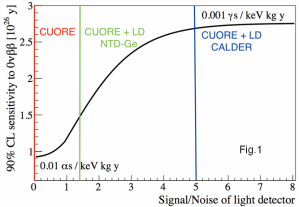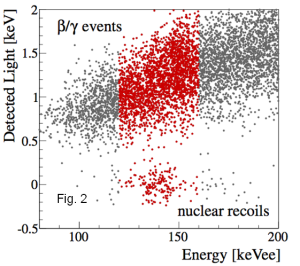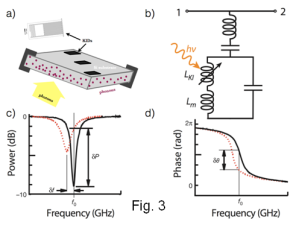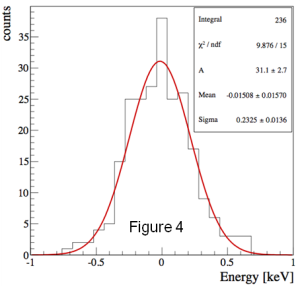Posters Excerpts 1: CALDER – Cryogenic Light Detectors for Rare Event Searches
While we wait for the start of Neutrino Telescopes XVI, we start today with an asynchronous series of posts describing the posters competing for the “best poster” award. The text below is from the author, Lorenzo Pagnanini.
—
The purpose of the CALDER project (Cryogenic wide-Area Light Detector with Excellent Resolution) is to develop new cryogenic light detectors to be used in CUORE and LUCIFER to improve the sensitivity in the search of neutrinoless double beta decay (0νββ) and dark matter.
The CUORE experiment is designed to search for the 0νββ decay of the 130Te (Q = 2528 keV). For this process we expect a monochromatic line at the Q-value of the decay in the sum spectrum of the two electrons, as neutrinos don’t subtract energy. A detector with high resolution and efficiency is required to separate the 0νββ signal from the 2νββ background, for this reason in CUORE we use crystals grown by Tellurium as bolometers. The detector of CUORE consists of 988 crystals of Tellurium dioxide (TeO2) in which 34% of Tellurium is 130Te; each crystal is a 0.75 kg cube with 5 cm of side, the total mass is 741 kg (208 kg of 130Te). The expected sensitivity on the half-life of the 0νββ decay of 130Te is about 1026 years in 5 years of data taking. As shown in the figure 1 the sensitivity of CUORE can be increased by a factor of 3, thanks to the reduction of the α background, obtained by detecting the Cherenkov light (∼100 eV) emitted by βs events and not by the α-background.
The LUCIFER project explores the possibility to build a scintillating bolometer experiment to search for 0νββ decay of isotopes with Q-values higher than 2615 keV (end of natural radioactivity) . There are three main possibilities for this kind of detectors: ZnSe crystals enriched in 82Se (Q = 2997 keV), ZnMoO4 crystals enriched in 100Mo (Q = 3034 keV) and CdWO4 crystals enriched in 116Cd (Q = 2814 keV). The β/γ background will decrease with respect to CUORE because the Q-values are above the bulk of the environmental γ radioactivity. On the other hand the use of scintillating crystals will help to reject the α-background, because these particles have a different light yield than the one of β/γ. This technique, in principle, allows to eliminate all the α background in LUCIFER and reach the so-called zero background condition. As a result in 5 years of data taking, LUCIFER is expected to get a sensitivity comparable to the CUORE one, but with a much smaller mass detector (36 bolometers with a total isotope mass of about 9.8 kg).
LUCIFER could have a broader physics potential if equipped with sensitive light detectors. Scintillating bolometers are widely used for dark matter searches, as the simultaneous read-out of heat and light allows to disentangle the energy region where WIMPS interactions are expected from the background due to electrons and gamma. The light detectors with an energy resolution of 20 eV RMS, if used in LUCIFER, allow to achieve enough sensitivity to discriminate nuclear recoils (due to WIMP interactions) from β/γ background in the low energy region (see figure 2).
New light detectors with an active area of 25 cm2, a baseline energy resolution of ∼ 20 eV RMS and a working temperature of 10 mK are mandatory. The technology chosen is based on the phonon-mediated kinetic inductance detectors (KIDs), in which the interacting photons are converted in phonons that break the Cooper Pairs condensed in a LC superconductor circuit as shown in detail in figure 3.
The best prototypes tested so far have a resolution of 230 eV on the baseline (see figure 4) and 365 eV (580 eV) to the 6.4 keV peak (14 keV) of 55Co source.



